What'sNEW April-June 2012
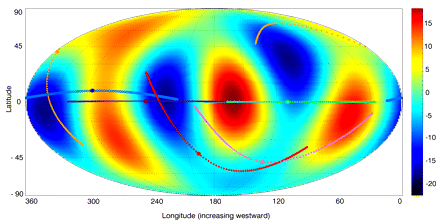 Titan has a liquid ocean 100 kilometers below its surface. This is the best explanation for tidal fluctuations observed in Titan's shape as it orbits Saturn every 16 days. The observations were made during six of the Cassini spacecraft's multiple flybys (elevation variances in meters, and flyby groundtracks pictured).
Titan has a liquid ocean 100 kilometers below its surface. This is the best explanation for tidal fluctuations observed in Titan's shape as it orbits Saturn every 16 days. The observations were made during six of the Cassini spacecraft's multiple flybys (elevation variances in meters, and flyby groundtracks pictured).
Saturn's Enceladus and three of Jupiter's moons very likely have subsurface oceans, so Titan would not be unique in that respect. But Titan is the only known moon with a thick atmosphere and with large lakes of methane. A liquid ocean there strengthens the possibility that life could have made, and may still be making, Titan's methane.
 The Tides of Titan by Luciano Iess et al., doi:10.1126/science.1219631, Science Express, online 28 Jun 2012. The Tides of Titan by Luciano Iess et al., doi:10.1126/science.1219631, Science Express, online 28 Jun 2012.
 Richard A. Kerr, "Cassini Spies an Ocean Inside Saturn's Icy, Gassy Moon Titan" [summary], doi:10.1126/science.336.6089.1629, p1629 v336, Science, 29 Jun 2012. Richard A. Kerr, "Cassini Spies an Ocean Inside Saturn's Icy, Gassy Moon Titan" [summary], doi:10.1126/science.336.6089.1629, p1629 v336, Science, 29 Jun 2012.
 Life on Europa, Other Moons, Other Planets? is a local webpage with related links. Search for "Titan". Life on Europa, Other Moons, Other Planets? is a local webpage with related links. Search for "Titan".
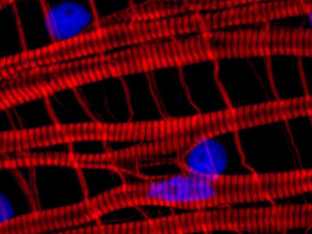
Close-up onto the striated (red, horizontal) and smooth (red, vertical) muscle cells of the hydrozoan jellyfish Clytia hemisphaerica. Cell nuclei are coloured in blue. Credit: Johanna Kraus |
"Here we show that a muscle protein core set, including a type II myosin heavy chain (MyHC) motor protein characteristic of striated muscles in vertebrates, was already present in unicellular organisms before the origin of multicellular animals." So write a team at the Centre for Organismal Systems Biology, University of Vienna, collaborating with researchers in Germany, France and Australia. They also conclude that the genes for other components of vertebrate muscles arose independently, several times.
 "As this specific myosin has so far only been found in muscle cells, we expected that its origin coincided with the evolution of muscle cells. We were very surprised to see that the 'muscle myosin' evolved probably in unicellular organisms, long before the first animals lived," explains Ulrich Technau who led the study. "As this specific myosin has so far only been found in muscle cells, we expected that its origin coincided with the evolution of muscle cells. We were very surprised to see that the 'muscle myosin' evolved probably in unicellular organisms, long before the first animals lived," explains Ulrich Technau who led the study.
 "This study sheds light onto how seemingly complex biological structures, such as striated muscles, could have evolved independently based on very ancient components." "This study sheds light onto how seemingly complex biological structures, such as striated muscles, could have evolved independently based on very ancient components."
Genes that exist before the appearance of the features they encode, and identical features that appear to evolve independently several times, are baffling for darwinism. But in cosmic ancestry, all genes are derived from "ancient components" that precede the features they encode. And following various gene transfer events, the genes would easily appear to have had multiple, independent origins.
 Patrick R. H. Steinmetz et al., "Independent evolution of striated muscles in cnidarians and bilaterians" [html], doi:10.1038/nature11180, Nature, online 27 Jun 2012. Patrick R. H. Steinmetz et al., "Independent evolution of striated muscles in cnidarians and bilaterians" [html], doi:10.1038/nature11180, Nature, online 27 Jun 2012.
 Searching for the origin of muscles by Ulrich Technau, University of Vienna (also EurekAlert!), 27 Jun 2012. Searching for the origin of muscles by Ulrich Technau, University of Vienna (also EurekAlert!), 27 Jun 2012.
 Metazoan Genes Older Than Metazoa? is a local webpage about genes older than the features they encode. Metazoan Genes Older Than Metazoa? is a local webpage about genes older than the features they encode.
 Viruses and Other Gene Transfer Mechanisms is a related local webpage. What'sNEW about HGT Viruses and Other Gene Transfer Mechanisms is a related local webpage. What'sNEW about HGT  | |
 Pedro Pereira replies and discussion ensues, 24-25 Jul 2012. Pedro Pereira replies and discussion ensues, 24-25 Jul 2012.
ESA's research on the International Space Station is giving credibility to theories that life came from outer space....

 The toughest life on Earth, European Space Agency, 22 Jun 2012. The toughest life on Earth, European Space Agency, 22 Jun 2012.
 Thanks for an alert, Jacob Navia. Thanks for an alert, Jacob Navia.
 Bacteria: The Space Colonists is a related local webpage. Bacteria: The Space Colonists is a related local webpage.
 Introduction: More Than Panspermia is a related local webpage. Introduction: More Than Panspermia is a related local webpage.
miRNAs from plants can enter animal cells and regulate their metabolic processes, a pair of botanists in France report. Micro RNAs (miRNAs) are short strands (typically 20 to 25 nucleotides) of non-protein coding RNA that bind to complementary sequences on mRNAs (much longer, protein coding RNAs) and modify their expression, usually by silencing them. They affect most animal and plant genes, although somewhat differently in plants.
"The authors of this study hypothesized that epithelial cells in the intestine might take up miRNAs in food, package them into MVs [plasma microvesicles] and release them into the circulatory sytem. The secreted MVs could then deliver exogenous plant miRNA to target organs where they could regulate cognate mRNAs."
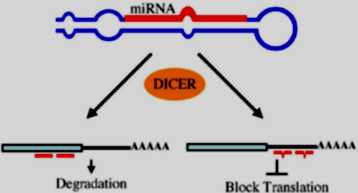 This expectation was upheld. Thus we see a way for an animal species, even humans, to acquire small genetic subroutines from the plant world. In this study the acquired miRNAs were observed to affect only somatic cells, and not germline cells. Still, very interesting.
This expectation was upheld. Thus we see a way for an animal species, even humans, to acquire small genetic subroutines from the plant world. In this study the acquired miRNAs were observed to affect only somatic cells, and not germline cells. Still, very interesting.
 Hervé Vaucheret and Yves Chupeau, "Ingested plant miRNAs regulate gene expression in animals" [html], doi:10.1038/cr.2011.164, p3-5 v22, Cell Research, Jan 2012. Hervé Vaucheret and Yves Chupeau, "Ingested plant miRNAs regulate gene expression in animals" [html], doi:10.1038/cr.2011.164, p3-5 v22, Cell Research, Jan 2012.
 Thanks, Monica C. Vella and Frank J. Slack, for the illustration of the "Dicer" miRNA in C. elegans from their online WormBook. Thanks, Monica C. Vella and Frank J. Slack, for the illustration of the "Dicer" miRNA in C. elegans from their online WormBook.
 Thanks for the alert, Jeff Krolick. Thanks for the alert, Jeff Krolick.
 Viruses and Other Gene Transfer Mechanisms is the main related local webpage. What'sNEW about HGT Viruses and Other Gene Transfer Mechanisms is the main related local webpage. What'sNEW about HGT  | |
A brief article about Chandra Wickramasinghe's work on panspermia is online and worth reading. The article includes Dr Lewis Dartnell's sceptical comments, to which astrobiologist Max Wallis posts a reply.
 Why the primordial soup may be an alien concoction by Tom Chivers, Telegraph Media Group, online 19 Jun 2012. Why the primordial soup may be an alien concoction by Tom Chivers, Telegraph Media Group, online 19 Jun 2012.
 An open-minded journalist against a panspermia-denier is Wallis's reply, posted on Astrobiology@Cardiff, 20 Jun 2012. An open-minded journalist against a panspermia-denier is Wallis's reply, posted on Astrobiology@Cardiff, 20 Jun 2012.
 An interview with Gerald Joyce about the definition of life, the possibility of life elsewhere and related topics is available as a podcast on the Internet. Joyce is a Professor of Molecular Biology and Biochemistry at the Scripps Research Institute in La Jolla, CA. He comments "It's just chemistry, but chemistry that has memory." Yes, memory is needed, but is it sufficient for ongoing evolutionary innovation? We doubt it, but the interview of 14 minutes is definitely worthwhile.
An interview with Gerald Joyce about the definition of life, the possibility of life elsewhere and related topics is available as a podcast on the Internet. Joyce is a Professor of Molecular Biology and Biochemistry at the Scripps Research Institute in La Jolla, CA. He comments "It's just chemistry, but chemistry that has memory." Yes, memory is needed, but is it sufficient for ongoing evolutionary innovation? We doubt it, but the interview of 14 minutes is definitely worthwhile.
 ...The Search for New Life Forms by Ruchir Shah, PLoS, with access to the interview by Megan Hall, 8 May 2012. ...The Search for New Life Forms by Ruchir Shah, PLoS, with access to the interview by Megan Hall, 8 May 2012.
 The definition of life and speculations about its origin(s): our article about the essay that prompted the interview, 10 May 2012. The definition of life and speculations about its origin(s): our article about the essay that prompted the interview, 10 May 2012.
 The RNA World... is a related local webpage with more about Gerald Joyce. The RNA World... is a related local webpage with more about Gerald Joyce.
Very young galaxies contain the heavy elements needed for life, according to new research from an international team using telescopes on the island of La Palma and in Chile. So, life could have existed already, ten to twelve billion years ago. Apparently, the big bang theory is not yet complete and final.
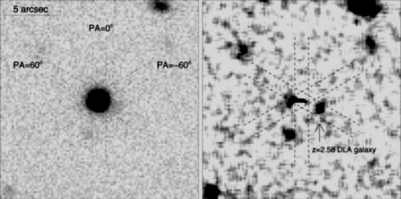
To the left is an image from the Nordic Optical Telescope of one of the quasars researchers have looked at. After having removed the quasar light from the image, the distant galaxy appears, which is indicated by an arrow in the image to the right. ...The galaxies from the very early Universe had a surprisingly large quantity of heavy elements. — Niels Bohr Institute |
"We have studied 10 galaxies in the early Universe and analysed their light spectra. We are observing light from the galaxies that has been on a 10-12 billion year journey to Earth, so we see the galaxies as they were then. Our expectation was that they would be relatively primitive and poor in heavier elements, but we discovered somewhat to our surprise that the gas in some of the galaxies and thus the stars in them had a very high content of heavier elements. The gas was just as enriched as our own Sun," explains Professor Johan Fynbo from the Dark Cosmology Centre at the Niels Bohr Institute, University of Copenhagen.
 J.-K. Krogager et al., "On the sizes of z≥2 damped Lyα absorbing galaxies" [abstract], doi:10.1111/j.1745-3933.2012.01272.x, Monthly Notices of the Royal Astronomical Society: Letters, online 15 May 2012. J.-K. Krogager et al., "On the sizes of z≥2 damped Lyα absorbing galaxies" [abstract], doi:10.1111/j.1745-3933.2012.01272.x, Monthly Notices of the Royal Astronomical Society: Letters, online 15 May 2012.
 Baby galaxies grew up quickly, Niels Bohr Institute, 16 May 2012. Baby galaxies grew up quickly, Niels Bohr Institute, 16 May 2012.
 Life might have formed as early as 10-12 billion years ago, World Science, 18 May 2012. Life might have formed as early as 10-12 billion years ago, World Science, 18 May 2012.
 The End and the Big Bang is a related local webpage. The End and the Big Bang is a related local webpage.
 Thanks, Stan Franklin. Thanks, Stan Franklin.
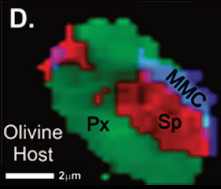 Did Mars ever support life? If so, evidence thereof in ancient Mars meteorites might be cryptic. Now however, an international team says that ubiquitously distributed organic carbon in martian igneous rocks must be "abiotic." Because MMC [macromolecular carbon] was always associated with igneous phases, we conclude that it crystallized from the host magma. This textural relationship negates any biological origin of the MMC and PAHs.
Did Mars ever support life? If so, evidence thereof in ancient Mars meteorites might be cryptic. Now however, an international team says that ubiquitously distributed organic carbon in martian igneous rocks must be "abiotic." Because MMC [macromolecular carbon] was always associated with igneous phases, we conclude that it crystallized from the host magma. This textural relationship negates any biological origin of the MMC and PAHs.
What? Have they seen those images of lava flowing down Hawaiian slopes into the sea? Doesn't that lava acquire organics from the biology it mops up? Couldn't the resulting material, after a few billion years of subsequent alteration, possibly exhibit a simlar ubiquitous distribution of organic carbon? We are truly puzzled.
 A. Steele et al., "A Reduced Organic Carbon Component in Martian Basalts" [abstract], doi:10.1126/science.1220715, Science, online 24 May 2012. A. Steele et al., "A Reduced Organic Carbon Component in Martian Basalts" [abstract], doi:10.1126/science.1220715, Science, online 24 May 2012.
 Richard A. Kerr, "Homegrown Organic Matter Found on Mars, But No Life" [summary], doi:10.1126/science.336.6084.970, Science, 25 May 2012. Richard A. Kerr, "Homegrown Organic Matter Found on Mars, But No Life" [summary], doi:10.1126/science.336.6084.970, Science, 25 May 2012.
 Life on Mars! is a related local webpage. Life on Mars! is a related local webpage.
A live interview about nomad or rogue planets in the Milky Way is scheduled for 9:00 AM PDT today, according to a foundation in Oxnard, California.
 Nomads of the Galaxy, transcript of earlier roundtable duiscussion, The Kavli Foundation, 24 May 2012. Nomads of the Galaxy, transcript of earlier roundtable duiscussion, The Kavli Foundation, 24 May 2012.
 Life on Europa, Other Moons, Other Planets? is a related local webpage. Life on Europa, Other Moons, Other Planets? is a related local webpage.
Proving Darwin by Gregory Chaitin is a very welcome book. A distinguished computer theoretician formerly with IBM, Chaitin affirms that the mainstream theory of evolution lacks a mathematical basis, which it sorely needs. Of course he proposes a new theory, in outline, and his proposal is interesting.
Beginning with insights from his heroes, mainly Alan Turing and John von Neumann, he defines biology as "software archaeology." We especially welcome his focus on software and his question, Where do new genes come from? He favors a scheme he calls cumulative evolution, using algorithmic (as opposed to point) mutations. He believes these could continually improve a given program's solution to the standard "Busy Beaver" problem, and this would constitute a logical proof of Darwinian evolution. And, as hinted by work in "evo-devo," algorithmic mutations might enable evolution to go much faster than the exhaustive search method, although not necessarily fast enough.

We are glad Chaitin knows that viruses can play a big part in evolution, installing their own or others' genes into species everywhere. But where those genes come from remains unanswered. And we suspect that experimenters who have already worked in Artificial Life for ten or twenty years may see Chaitin's newly announced field of "metabiology" as simply another suggestion among many. But if his enthusiasm ignites new interest in Artificial Life, excellent.
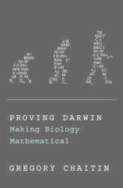 Before 1887, Al Michelson and Edward Morley looked for the luminous aether that, they were sure, had to exist. That year, their definitive experiment detected none. Subsequently, science recognized new possibilities and the theory of relativity ensued. Similarly, Chaitin wants to prove what he is already sure about. But he thinks the proof might take 300 years. So, apparently, no amount of failure would prompt him to consider other possibilities? This seems unscientific to us.
Before 1887, Al Michelson and Edward Morley looked for the luminous aether that, they were sure, had to exist. That year, their definitive experiment detected none. Subsequently, science recognized new possibilities and the theory of relativity ensued. Similarly, Chaitin wants to prove what he is already sure about. But he thinks the proof might take 300 years. So, apparently, no amount of failure would prompt him to consider other possibilities? This seems unscientific to us.
Complaints aside, Proving Darwin is a fun and easy read. Chaitin knows the history of computers, and compares modern, artificial sortware to DNA's ancient, natural software as few others do. Recommended!
 Gregory Chaitin, Proving Darwin: Making Biology Mathematical, ISBN: 978-0-375-42314-7, 144 pages, Random House, Inc. [publisher's promo], 8 May 2012. Gregory Chaitin, Proving Darwin: Making Biology Mathematical, ISBN: 978-0-375-42314-7, 144 pages, Random House, Inc. [publisher's promo], 8 May 2012.
 Life as Evolving Software, lecture by Greg Chaitin with Q&A at PPGC UFRGS, 79min Youtube video, posted 1 Sep 2011. Life as Evolving Software, lecture by Greg Chaitin with Q&A at PPGC UFRGS, 79min Youtube video, posted 1 Sep 2011.
 Computer Models of Evolution and the four "Next" pages are related local webpages. Computer Models of Evolution and the four "Next" pages are related local webpages.
 The Evolution Prize... is a related local webpage with links to the Evolution Prize website. The Evolution Prize... is a related local webpage with links to the Evolution Prize website.
Viable aerobic bacteria have been recovered in seafloor sediment buried 86 million years ago. The international team who found them calculate that their metabolism was deeply, but not completely, diminished in the dark, oxygen-poor, organics-deprived, high-pressure environment. We already know that bacteria can remain viable indefinitely with no metabolism, when frozen, for example. Now we see that they have another way to endure.
Their ability to survive in such impoverished conditions supports the belief that bacteria could also survive in material ejected into space from a planet by an asteroid impact. Such space-borne microbes could later be deposited, as stowaways on a meteorite, on a different planet.
 Hans Røy et al., "Aerobic Microbial Respiration in 86-Million-Year-Old Deep-Sea Red Clay" [abstract], doi:10.1126/science.1219424, p922-925 v336, Science, 18 May 2012. Hans Røy et al., "Aerobic Microbial Respiration in 86-Million-Year-Old Deep-Sea Red Clay" [abstract], doi:10.1126/science.1219424, p922-925 v336, Science, 18 May 2012.
 Joel Achenbach, "Ancient life, potentially millions of years old and barely alive, found beneath ocean floor" [html], The Washington Post, online 17 May 2012. Joel Achenbach, "Ancient life, potentially millions of years old and barely alive, found beneath ocean floor" [html], The Washington Post, online 17 May 2012.
 Slo-mo microbes extend the frontiers of life by Leigh Phillips, Nature News, 17 May 2012. Slo-mo microbes extend the frontiers of life by Leigh Phillips, Nature News, 17 May 2012.
 Buried microbes exist at limit between life and death by Colin Barras, NewScientist, 17 May 2012. Buried microbes exist at limit between life and death by Colin Barras, NewScientist, 17 May 2012.
 Bacteria: The Space Colonists is a related local webpage. Bacteria: The Space Colonists is a related local webpage.
 Thanks, Bob Sweeney and Stan Franklin. Thanks, Bob Sweeney and Stan Franklin.
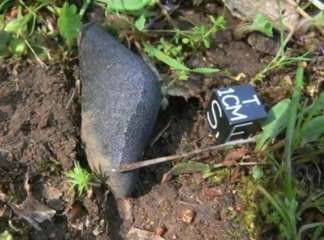 The Sutter's Mill meteorite boomed and streaked brightly across the skies of Nevada and California around 7:51 AM PDT Sunday 22 April. It is estimated to have been "about the size of a minivan," and fragments of it are still being sought east of Sacramento, near the landmark for which it is named. Early-found pieces (example pictured) show it to be a carbonaceous chondrite, in the same category as Orgueil, Murchison and others. These contain microfossils that, if valid (biological, not contaminants), constitute evidence for extraterrestrial life. Sutter's Mill may contain similar microfossils. We will watch for more news.
The Sutter's Mill meteorite boomed and streaked brightly across the skies of Nevada and California around 7:51 AM PDT Sunday 22 April. It is estimated to have been "about the size of a minivan," and fragments of it are still being sought east of Sacramento, near the landmark for which it is named. Early-found pieces (example pictured) show it to be a carbonaceous chondrite, in the same category as Orgueil, Murchison and others. These contain microfossils that, if valid (biological, not contaminants), constitute evidence for extraterrestrial life. Sutter's Mill may contain similar microfossils. We will watch for more news.
 Sutter's Mill Meteorite, Astronomy Picture of the Day, 28 Apr 2012. Sutter's Mill Meteorite, Astronomy Picture of the Day, 28 Apr 2012.
 NASA Ames Helps Search For and Study of Sutter's Mill Meteorites, with a short video, NASA, 28 Apr 2012. NASA Ames Helps Search For and Study of Sutter's Mill Meteorites, with a short video, NASA, 28 Apr 2012.
 Meteorites From Big Fireball Spark Space Age 'Gold Rush', Space.com, 11 May 2012. Meteorites From Big Fireball Spark Space Age 'Gold Rush', Space.com, 11 May 2012.
 Meteorite Discovery Spurs Hunt For More Pieces, SpaceDaily, 14 May 2012. Meteorite Discovery Spurs Hunt For More Pieces, SpaceDaily, 14 May 2012.
 The Impact and Recovery of the Sutter's Mill Meteorite, NASA's list of recovered fragments, beginning 24 Apr 2012. The Impact and Recovery of the Sutter's Mill Meteorite, NASA's list of recovered fragments, beginning 24 Apr 2012.
 Comets: The Delivery System is a related local webpage. Comets: The Delivery System is a related local webpage.
 Thanks, Richard Hoover, who has a sample to examine. (See What'sNEW, 3 Mar 2011 and links from there.) Thanks, Richard Hoover, who has a sample to examine. (See What'sNEW, 3 Mar 2011 and links from there.)
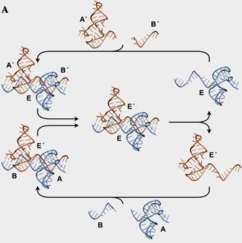 The definition of life and speculations about its origin(s) are the subjects of a new essay by molecular biologist and biochemist Gerald Joyce of the Scripps Research Institute. He especially considers the minimum information content needed for life to begin. We admire the focus and clarity of the essay. Still, for understanding the origin of life, the gaps look to us as wide as ever. But see for yourself.
The definition of life and speculations about its origin(s) are the subjects of a new essay by molecular biologist and biochemist Gerald Joyce of the Scripps Research Institute. He especially considers the minimum information content needed for life to begin. We admire the focus and clarity of the essay. Still, for understanding the origin of life, the gaps look to us as wide as ever. But see for yourself.
 Gerald F. Joyce, "Bit by Bit: The Darwinian Basis of Life" [html], doi:10.1371/journal.pbio.1001323, 10(5): e1001323, PLoS Biol, online 8 May 2012. Gerald F. Joyce, "Bit by Bit: The Darwinian Basis of Life" [html], doi:10.1371/journal.pbio.1001323, 10(5): e1001323, PLoS Biol, online 8 May 2012.
 The Joyce Laboratory homepage. The Joyce Laboratory homepage.
 What Is Life? is a related local webpage. What Is Life? is a related local webpage.
 The RNA World... is the main local webpage about origin-of-life theories. The RNA World... is the main local webpage about origin-of-life theories.
 Macroevolutionary Progress Redefined... also discusses the information content of life. Macroevolutionary Progress Redefined... also discusses the information content of life.
 An interview with Gerald Joyce is available on the Intenet, What'sNEW, 7 Jun 2012. An interview with Gerald Joyce is available on the Intenet, What'sNEW, 7 Jun 2012.
Life-bearing planets may exist in vast numbers in the space between stars in the Milky Way according to a new report from the Buckingham Centre for Astrobiology. These planets could account for much the galaxy's missing mass, and might disseminate primordial life.
 NC Wickramasinghe et al., "Life-bearing primordial planets in the solar vicinity" [link], doi:10.1007/s10509-012-1092-8, Astrophysics and Space Science, online 10 May 2012. NC Wickramasinghe et al., "Life-bearing primordial planets in the solar vicinity" [link], doi:10.1007/s10509-012-1092-8, Astrophysics and Space Science, online 10 May 2012.
 Instead of "dark matter," rogue planets?, World Science, 13 May 2012. Instead of "dark matter," rogue planets?, World Science, 13 May 2012.
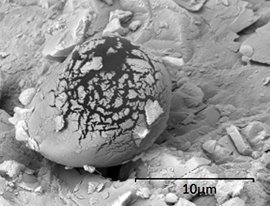 A new Mars meteorite may contain biological fossils, according to Prof. Chandra Wickramasinghe's team at the Buckingham Centre for Astrobiology.
A new Mars meteorite may contain biological fossils, according to Prof. Chandra Wickramasinghe's team at the Buckingham Centre for Astrobiology.
 Jamie Wallis, Chandra Wickramasinghe, Daryl Wallis, Nori Miyake, Max Wallis, Barry Di Gregorio and Shirwan Al Mufti, "Discovery of Biological Structures in the Tissint Mars Meteorite" [local pdf], Journal of Cosmology, 27 Apr 2012. Jamie Wallis, Chandra Wickramasinghe, Daryl Wallis, Nori Miyake, Max Wallis, Barry Di Gregorio and Shirwan Al Mufti, "Discovery of Biological Structures in the Tissint Mars Meteorite" [local pdf], Journal of Cosmology, 27 Apr 2012.
 Scientists: Mars 'egg' proof of life by Paul Sutherland, The Sun, also SkyMania, 27 Apr 2012 (links have died). Scientists: Mars 'egg' proof of life by Paul Sutherland, The Sun, also SkyMania, 27 Apr 2012 (links have died).
 Buckingham Centre for Astrobiology homepage. Buckingham Centre for Astrobiology homepage.
 Life on Mars! is a related local webpage. Life on Mars! is a related local webpage.
 Chandra Wickramasinghe is a related local webpage. Chandra Wickramasinghe is a related local webpage.
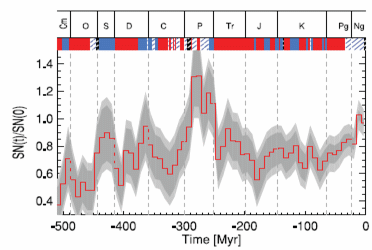
Variations in SN rate (linear graph) and geologic strata (top) |
Do supernovae enhance the rate of speciation? A Danish astronomer promotes this hypothesis after noticing that bursts of biological diversification correlate with the solar system's regular passage through the galaxy's spiral arms. Supernovae (SN) are relatively abundant there. Cosmic rays from their remnants enhance the formation of low clouds that increase Earth's albedo and cool it. These environmental changes would force species to adapt or die out, according to this theory. It may be so. We note that the galactic arms may include other differences, such as heavier comet traffic.
 Henrik Svensmark, "Evidence of nearby supernovae affecting life on Earth" [doi:10.1111/j.1365-2966.2012.20953.x], Monthly Notices of the Royal Astronomical Society, online 24 Apr 2012. Henrik Svensmark, "Evidence of nearby supernovae affecting life on Earth" [doi:10.1111/j.1365-2966.2012.20953.x], Monthly Notices of the Royal Astronomical Society, online 24 Apr 2012.
 "Did exploding stars help life on Earth to thrive?" RAS via ScienceDaily and
PhysOrg, 24 Apr 2012. "Did exploding stars help life on Earth to thrive?" RAS via ScienceDaily and
PhysOrg, 24 Apr 2012.
 Thanks for an alert, Jack Foster, iii. Thanks for an alert, Jack Foster, iii.
An astrobiologist is leading a group of 20 scientists in calling for a mission to Mars with a strong and comprehensive life detection component. This is good news, because NASA is dodging or indefinitely postponing this question, it seems. At NASA's Astrobiology Conference (AbSciCon) 12-16 April, in Atlanta, there was much discussion of the Mars Science Laboratory (MSL) mission that is currently en route to Mars with a one-ton rover packed with experiments. At a plenary session Tuesday afternoon, mission leaders explained that the rover would not look for life, but for "conditions favorable to life." For that, 5 August 2012, the rover will land in Gale crater, whose floor is among the very lowest places on the red planet, where water likely would have pooled.
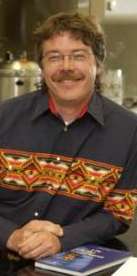 When I asked why MSL wasn't looking for life, NASA's representative answered that it is difficult to identify biological fossils on Earth, so it would be much harder on Mars. But I was asking about viable life such as Viking may have detected, not fossils. I felt that we were speaking different languages. I was too stunned to followup. Good for Dirk Schulze-Makuch (pictured) of Washington State University, for promoting an actual search for life on Mars. The project is named Biological Oxidant and Life Detection (BOLD).
When I asked why MSL wasn't looking for life, NASA's representative answered that it is difficult to identify biological fossils on Earth, so it would be much harder on Mars. But I was asking about viable life such as Viking may have detected, not fossils. I felt that we were speaking different languages. I was too stunned to followup. Good for Dirk Schulze-Makuch (pictured) of Washington State University, for promoting an actual search for life on Mars. The project is named Biological Oxidant and Life Detection (BOLD).
In 1976-77, the LR experiments on both Viking landers detected life by their preestablished criteria. Strictly chemical explanations for the positive results were proposed only post hoc, to the frustration of Gil Levin's team who designed the experiment. Now Levin has designed an improved, tandem version of the LR experiment using chiral molecules. If both chiralities produce the same result, nonbiological chemistry is the likeliest cause. But if they give different results, life is clearly implicated. Could BOLD include this experiment?
 Dirk Schulze-Makuch et al., "The Biological Oxidant and Life Detection (BOLD) mission: A proposal for a mission to Mars" [abstract & figures], Planetary and Space Science, online 29 Mar 2012. Dirk Schulze-Makuch et al., "The Biological Oxidant and Life Detection (BOLD) mission: A proposal for a mission to Mars" [abstract & figures], Planetary and Space Science, online 29 Mar 2012.
 WSU astrobiologist proposes fleet of probes to Mars, by Eric Sorensen, Washington State University via EurekAlert, 23 Apr 2012. WSU astrobiologist proposes fleet of probes to Mars, by Eric Sorensen, Washington State University via EurekAlert, 23 Apr 2012.
 Mars Science Laboratory (MSL), NSSDC ID: 2011-070A, NASA. Mars Science Laboratory (MSL), NSSDC ID: 2011-070A, NASA.
 Life on Mars! is a local webpage with more about the LR experiment. Life on Mars! is a local webpage with more about the LR experiment.
I polled several experts at AbSciCon about fossilized microorganisms in carbonaceous meteorites, especially the ones photographed by NASA's Richard Hoover. The experts included Steven Benner of the Foundation For Applied Molecular Evolution; Robert Hazen of the Carnegie Institution of Washington's Geophysical Laboratory, and of George Mason University; and George E. Fox of the University of Houston. All were well aware of Hoover's evidence. My concluding observation is this: in his own field of expertise each one agrees with Hoover. Chemists acknowledge that the fossils can not be recent biological contaminants. Microbiologists recognize that the fossils are biological. But to a person, they assume that there must be a problem in some other area that they know little about. Why?!
 Fossilized bacteria in meteorites are obvious... is a What'sNEW article about Hoover's evidence, with a photograph and links, 3 Mar 2011. Fossilized bacteria in meteorites are obvious... is a What'sNEW article about Hoover's evidence, with a photograph and links, 3 Mar 2011.
 More Evidence for Indigenous Microfossils in Carbonaceous Meteorites is one of several webpages about Hoover's evidence, posted 15 Aug 2010. More Evidence for Indigenous Microfossils in Carbonaceous Meteorites is one of several webpages about Hoover's evidence, posted 15 Aug 2010.
 Astrobiology Science Conference..., Atlanta GA, 16-20 Apr 2012 (Link died). Astrobiology Science Conference..., Atlanta GA, 16-20 Apr 2012 (Link died).
Physicists estimate that life from Earth could have seeded other planets. Beginning with reasonable assumptions about the impact that created Earth's Chicxulub crater c. 65 million years ago, they calculate the likelihood that particles ejected from it could arrive at bodies including Mars, Enceladus, Europa and even an extra-solar planet 20 lightyears distant. They conclude that Earth-originating panspermia (sometimes called "reverse panspermia") is plausible, and that earlier panspermia could account for the origin of life on Earth.
 Tetsuya Hara et al., "Transfer of Life-Bearing Meteorites from Earth to Other Planets" [abstract | pdf], arXiv:1204.1719v1 [astro-ph.EP], 8 Apr 2012. Tetsuya Hara et al., "Transfer of Life-Bearing Meteorites from Earth to Other Planets" [abstract | pdf], arXiv:1204.1719v1 [astro-ph.EP], 8 Apr 2012.
 The Amazing Trajectories of Life-Bearing Meteorites from Earth, The Physics arXiv Blog published by MIT, 11 Apr 2012. The Amazing Trajectories of Life-Bearing Meteorites from Earth, The Physics arXiv Blog published by MIT, 11 Apr 2012.
 Panspermia and Transfer of Life Between Planets by Tahir Yaqoob, posted 24 May 2012. Panspermia and Transfer of Life Between Planets by Tahir Yaqoob, posted 24 May 2012.
 Introduction: More Than Panspermia is a related local webpage. Introduction: More Than Panspermia is a related local webpage.
 Thanks, Google Alerts. Thanks, Google Alerts.
"...(d) Neither the state board of education, nor any public elementary or secondary school governing authority, director of schools, school system administrator, or any public elementary or secondary school principal or administrator shall prohibit any teacher in a public school system of this state from helping students understand, analyze, critique, and review in an objective manner the scientific strengths and scientific weaknesses of existing scientific theories covered in the course being taught."
 SENATE BILL 893 [PDF] SENATE BILL 893 [PDF]
 HOUSE BILL 368 [PDF] HOUSE BILL 368 [PDF] | |
Tennessee has passed a law that allows high school science classes to consider problems with the theory of evolution and other theories. The bill passed both legislative bodies by veto-proof majorities; Governor Bill Haslam (pictured) did not sign it. According to commentary, "The law protects teachers from discipline for teaching scientific subjects in an objective manner or helping students understand, analyze, critique and review in an objective manner the scientific strengths and scientific weaknesses of existing scientific theories." What's wrong with that?
 The law makes no reference to creationism or Intelligent Design, so it will not so easily be overturned in court. Nonetheless, committed darwinists and other, well-meaning activists are complaining that the bill is merely a trojan horse to sneak religion into science class. Obviously, the gridlock between darwinism and creationism/ID is as rigid as ever.
The law makes no reference to creationism or Intelligent Design, so it will not so easily be overturned in court. Nonetheless, committed darwinists and other, well-meaning activists are complaining that the bill is merely a trojan horse to sneak religion into science class. Obviously, the gridlock between darwinism and creationism/ID is as rigid as ever.
Here in our home state, maybe science teachers will ask us for a third opinion? We'll see.
 Tennessee evolution bill becomes law without governor's signature, by Jane Roberts, Commercial Appeal, Memphis TN, 10 Apr 2012. Tennessee evolution bill becomes law without governor's signature, by Jane Roberts, Commercial Appeal, Memphis TN, 10 Apr 2012.
 Tennessee enacts evolution, climate change law by Neela Banerjee, Los Angeles Times, 11 Apr 2012. Tennessee enacts evolution, climate change law by Neela Banerjee, Los Angeles Times, 11 Apr 2012.
 Tennessee Evolution Bill Becomes Law After Governor Bill Haslam Declines To Act by Nick Wing, Huffington Post, 10 Apr 2012. Tennessee Evolution Bill Becomes Law After Governor Bill Haslam Declines To Act by Nick Wing, Huffington Post, 10 Apr 2012.
 Confusion Reigns in Tennessee, by Jeffrey Mervis, ScienceInsider, 11 Apr 2012. Confusion Reigns in Tennessee, by Jeffrey Mervis, ScienceInsider, 11 Apr 2012.
 Comparing Darwinism, Creationism/ID and Cosmic Ancestry is a related local webpage. Comparing Darwinism, Creationism/ID and Cosmic Ancestry is a related local webpage.
 Evolution versus Creationism is a related local webpage with more about gridlock. Evolution versus Creationism is a related local webpage with more about gridlock.
 Creationism versus Darwinism: A Third Alternative is a related CA reprint. Creationism versus Darwinism: A Third Alternative is a related CA reprint.
Our results indicate that reuse of globally shared standing genetic variation, including chromosomal inversions, has an important role in repeated evolution of distinct marine and freshwater sticklebacks, and in the maintenance of divergent ecotypes during early stages of reproductive isolation.
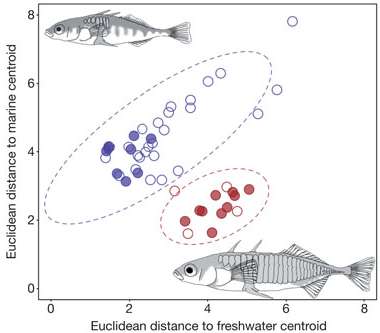 A distinguished international team has studied how stickleback fish have adapted from saltwater to freshwater habitats, apparently thousands of times. To do so, the researchers sequenced the whole genomes of a representative sample of 20 fish from both categories around the world. They found that certain genetic loci are consistently involved in the adqaptation, and that 87% of these are in regulatory, as opposed to coding, regions. In commentary, Hopi E. Hoekstra observes, Thus, it seems that repeated evolution of traits may often, but not always, arise from genetic variation that already existed in an ancestral population.
A distinguished international team has studied how stickleback fish have adapted from saltwater to freshwater habitats, apparently thousands of times. To do so, the researchers sequenced the whole genomes of a representative sample of 20 fish from both categories around the world. They found that certain genetic loci are consistently involved in the adqaptation, and that 87% of these are in regulatory, as opposed to coding, regions. In commentary, Hopi E. Hoekstra observes, Thus, it seems that repeated evolution of traits may often, but not always, arise from genetic variation that already existed in an ancestral population.
Making use of genetic programs that already exist is standard procedure in cosmic ancestry. Of course, nothing prevents strictly darwinian evolution from deploying pre-existing programs as well. Darwinism however, purports also to account for the origins of those programs. Where is that evidence?
 Felicity C. Jones et al., "The genomic basis of adaptive evolution in threespine sticklebacks" [html], doi:10.1038/nature10944, p55-61 v484, Nature, 5 Apr 2012. Felicity C. Jones et al., "The genomic basis of adaptive evolution in threespine sticklebacks" [html], doi:10.1038/nature10944, p55-61 v484, Nature, 5 Apr 2012.
 Hopi E. Hoekstra, "Genomics: Stickleback is the catch of the day" [html], doi:10.1038/484046a, p46-47 v484, Nature, 5 Apr 2012. Hopi E. Hoekstra, "Genomics: Stickleback is the catch of the day" [html], doi:10.1038/484046a, p46-47 v484, Nature, 5 Apr 2012.
 Mary Muers, "Evo-devo: Stickleback genomes illuminate adaptive evolution" [abstract], doi:10.1038/nrg3236, p299 v13, Nature Reviews Genetics, May 2012. Mary Muers, "Evo-devo: Stickleback genomes illuminate adaptive evolution" [abstract], doi:10.1038/nrg3236, p299 v13, Nature Reviews Genetics, May 2012.
 Stickleback genomes reveal path of evolution by Helen Shen, doi:10.1038/nature.2012.10392, Nature.com, 4 Apr 2012. Stickleback genomes reveal path of evolution by Helen Shen, doi:10.1038/nature.2012.10392, Nature.com, 4 Apr 2012.
 ...Genetic changes that underlie the big steps in evolution? is a What'sNEW article about earlier research with sticklebacks by some of the same researchers, 14 Apr 2004. ...Genetic changes that underlie the big steps in evolution? is a What'sNEW article about earlier research with sticklebacks by some of the same researchers, 14 Apr 2004.
 Comparing Darwinism, Creationism/ID and Cosmic Ancestry is a related local webpage. Comparing Darwinism, Creationism/ID and Cosmic Ancestry is a related local webpage.
Conventional knowledge is usually based on some evident truth, above which is reared a superstructure of misunderstanding and fallacy.
 Jacques Barzun, "William James: The Mind as Artist," (1985), republished: p35-39, The Jacques Barzun Reader, Michael Murray, ed., HarperCollins Publishers, 2002. Jacques Barzun, "William James: The Mind as Artist," (1985), republished: p35-39, The Jacques Barzun Reader, Michael Murray, ed., HarperCollins Publishers, 2002.
|
 Titan has a liquid ocean 100 kilometers below its surface. This is the best explanation for tidal fluctuations observed in Titan's shape as it orbits Saturn every 16 days. The observations were made during six of the Cassini spacecraft's multiple flybys (elevation variances in meters, and flyby groundtracks pictured).
Titan has a liquid ocean 100 kilometers below its surface. This is the best explanation for tidal fluctuations observed in Titan's shape as it orbits Saturn every 16 days. The observations were made during six of the Cassini spacecraft's multiple flybys (elevation variances in meters, and flyby groundtracks pictured).

 An interview with Gerald Joyce about the definition of life, the possibility of life elsewhere and related topics is available as a podcast on the Internet. Joyce is a Professor of Molecular Biology and Biochemistry at the Scripps Research Institute in La Jolla, CA. He comments "It's just chemistry, but chemistry that has memory." Yes, memory is needed, but is it sufficient for ongoing evolutionary innovation? We doubt it, but the interview of 14 minutes is definitely worthwhile.
An interview with Gerald Joyce about the definition of life, the possibility of life elsewhere and related topics is available as a podcast on the Internet. Joyce is a Professor of Molecular Biology and Biochemistry at the Scripps Research Institute in La Jolla, CA. He comments "It's just chemistry, but chemistry that has memory." Yes, memory is needed, but is it sufficient for ongoing evolutionary innovation? We doubt it, but the interview of 14 minutes is definitely worthwhile. Did Mars ever support life? If so, evidence thereof in ancient Mars meteorites might be cryptic. Now however, an international team says that ubiquitously distributed organic carbon in martian igneous rocks must be "abiotic." Because MMC [macromolecular carbon] was always associated with igneous phases, we conclude that it crystallized from the host magma. This textural relationship negates any biological origin of the MMC and PAHs.
Did Mars ever support life? If so, evidence thereof in ancient Mars meteorites might be cryptic. Now however, an international team says that ubiquitously distributed organic carbon in martian igneous rocks must be "abiotic." Because MMC [macromolecular carbon] was always associated with igneous phases, we conclude that it crystallized from the host magma. This textural relationship negates any biological origin of the MMC and PAHs.
 The Sutter's Mill meteorite boomed and streaked brightly across the skies of Nevada and California around 7:51 AM PDT Sunday 22 April. It is estimated to have been "about the size of a minivan," and fragments of it are still being sought east of Sacramento, near the landmark for which it is named. Early-found pieces (example pictured) show it to be a carbonaceous chondrite, in the same category as Orgueil, Murchison and others. These contain microfossils that, if valid (biological, not contaminants), constitute evidence for extraterrestrial life. Sutter's Mill may contain similar microfossils. We will watch for more news.
The Sutter's Mill meteorite boomed and streaked brightly across the skies of Nevada and California around 7:51 AM PDT Sunday 22 April. It is estimated to have been "about the size of a minivan," and fragments of it are still being sought east of Sacramento, near the landmark for which it is named. Early-found pieces (example pictured) show it to be a carbonaceous chondrite, in the same category as Orgueil, Murchison and others. These contain microfossils that, if valid (biological, not contaminants), constitute evidence for extraterrestrial life. Sutter's Mill may contain similar microfossils. We will watch for more news. The definition of life and speculations about its origin(s) are the subjects of a new essay by molecular biologist and biochemist Gerald Joyce of the Scripps Research Institute. He especially considers the minimum information content needed for life to begin. We admire the focus and clarity of the essay. Still, for understanding the origin of life, the gaps look to us as wide as ever. But see for yourself.
The definition of life and speculations about its origin(s) are the subjects of a new essay by molecular biologist and biochemist Gerald Joyce of the Scripps Research Institute. He especially considers the minimum information content needed for life to begin. We admire the focus and clarity of the essay. Still, for understanding the origin of life, the gaps look to us as wide as ever. But see for yourself.






 Before 1887, Al Michelson and Edward Morley looked for the luminous aether that, they were sure, had to exist. That year, their definitive experiment detected none. Subsequently, science recognized new possibilities and the theory of relativity ensued. Similarly, Chaitin wants to prove what he is already sure about. But he thinks the proof might take 300 years. So, apparently, no amount of failure would prompt him to consider other possibilities? This seems unscientific to us.
Before 1887, Al Michelson and Edward Morley looked for the luminous aether that, they were sure, had to exist. That year, their definitive experiment detected none. Subsequently, science recognized new possibilities and the theory of relativity ensued. Similarly, Chaitin wants to prove what he is already sure about. But he thinks the proof might take 300 years. So, apparently, no amount of failure would prompt him to consider other possibilities? This seems unscientific to us.

 When I asked why MSL wasn't looking for life, NASA's representative answered that it is difficult to identify biological fossils on Earth, so it would be much harder on Mars. But I was asking about viable life such as Viking may have detected, not fossils. I felt that we were speaking different languages. I was too stunned to followup. Good for Dirk Schulze-Makuch (pictured) of Washington State University, for promoting an actual search for life on Mars. The project is named Biological Oxidant and Life Detection (BOLD).
When I asked why MSL wasn't looking for life, NASA's representative answered that it is difficult to identify biological fossils on Earth, so it would be much harder on Mars. But I was asking about viable life such as Viking may have detected, not fossils. I felt that we were speaking different languages. I was too stunned to followup. Good for Dirk Schulze-Makuch (pictured) of Washington State University, for promoting an actual search for life on Mars. The project is named Biological Oxidant and Life Detection (BOLD).
 The law makes no reference to creationism or Intelligent Design, so it will not so easily be overturned in court. Nonetheless, committed darwinists and other, well-meaning activists are complaining that the bill is merely a trojan horse to sneak religion into science class. Obviously, the gridlock between darwinism and creationism/ID is as rigid as ever.
The law makes no reference to creationism or Intelligent Design, so it will not so easily be overturned in court. Nonetheless, committed darwinists and other, well-meaning activists are complaining that the bill is merely a trojan horse to sneak religion into science class. Obviously, the gridlock between darwinism and creationism/ID is as rigid as ever. A distinguished international team has studied how stickleback fish have adapted from saltwater to freshwater habitats, apparently thousands of times. To do so, the researchers sequenced the whole genomes of a representative sample of 20 fish from both categories around the world. They found that certain genetic loci are consistently involved in the adqaptation, and that 87% of these are in regulatory, as opposed to coding, regions. In commentary, Hopi E. Hoekstra observes, Thus, it seems that repeated evolution of traits may often, but not always, arise from genetic variation that already existed in an ancestral population.
A distinguished international team has studied how stickleback fish have adapted from saltwater to freshwater habitats, apparently thousands of times. To do so, the researchers sequenced the whole genomes of a representative sample of 20 fish from both categories around the world. They found that certain genetic loci are consistently involved in the adqaptation, and that 87% of these are in regulatory, as opposed to coding, regions. In commentary, Hopi E. Hoekstra observes, Thus, it seems that repeated evolution of traits may often, but not always, arise from genetic variation that already existed in an ancestral population.